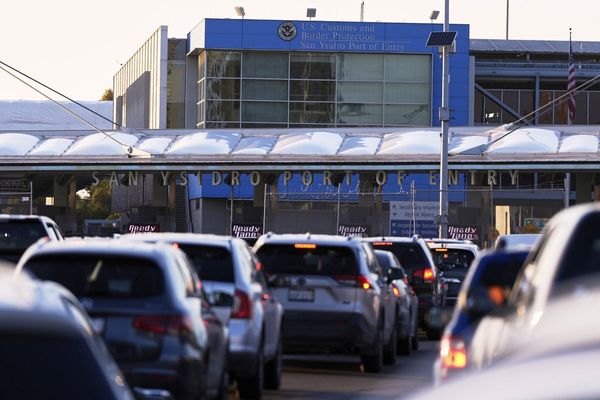Major changes new changes to the Highway Code are being introduced from Saturday (January 29).
The new rules will mean that drivers can been fined for things like changing the song on their phone wile driving or stopping beyond a white line.
All motorists are being urged to become familiar with the new changes, which are aimed at improving road safety for people walking, cycling and riding horses.
Read more: Highway Code changes go live today amid concern over drivers’ lack of awareness
It follows a public consultation on a review of The Highway Code, which was carried out between July and October 2020 to look at improving road safety.
Bristol Live reports that under the new rules, pedestrians, cyclists and horse riders will have priority over larger vehicles.
Using mobile phone to change song while driving
New laws aimed at cutting out dangerous driving now state that people changing the song on their phone while they drive can be hit with a fine.
This also includes other actions like taking pictures or videos. Fiddling with your phone in this way while driving may get you slapped with a £200 fine and even a possible six points on your licence.
Under the law as it stands, drivers are banned from texting or making a call other than in an emergency, wording that dates back to when phones were more limited when rules were first introduced in 2003.
This latest change catches up with other phone usage laws, making motorists who use their smartphone in different ways responsible for dangerous driving.
Throwing cigarette butt out of a car window
“Incorrect disposal of a cigarette” can land motorists a fixed penalty notice fine of anywhere between £50 and £100. Throwing a cigarettes butt is considered littering and therefore an environmental offence.
Smoking in a car is not a crime as long as the passengers are over 18, however, the fine was introduced to cut down littering and prevent the level of plastic-based butts discarded to align with current littering laws.
Having a dirty number plate
It can be easier for muck and grime to build up on your licence plate from driving on wet roads, especially in winter. But failure to keep your plate clear and visible can result in a whopping £1,000 fine.
If your plate is unreadable then you are breaking the Highway Code, which says: "Lights, indicators and number plates must be kept clean and clear."
Drivers should remember to clean their vehicles soon after driving on muddy or wet roads.
Hierarchy of road users
The introduction section of The Highway Code will be updated to include three rules about the new ‘hierarchy of road users’.
The hierarchy places those road users most at risk in the event of a collision at the top of the hierarchy. It does not remove the need for everyone to behave responsibly.
It’s important that all road users:
- are aware of The Highway Code
- are considerate to other road users
- understand their responsibility for the safety of others
The three new rules are numbered H1, H2, and H3.
People crossing the road at junctions
The updated code will clarify that:
- when people are crossing or waiting to cross at a junction, other traffic should give way
- if people have started crossing and traffic wants to turn into the road, the people crossing have priority and the traffic should give way
- people driving, riding a motorcycle or cycling must give way to people on a zebra crossing and people walking and cycling on a parallel crossing
A parallel crossing is similar to a zebra crossing but includes a cycle route alongside the black and white stripes.
Walking, cycling or riding in shared spaces
There will be new guidance in the code about routes and spaces which are shared by people walking, cycling and riding horses.
People cycling, riding a horse or driving a horse-drawn vehicle should respect the safety of people walking in these spaces, but people walking should also take care not to obstruct or endanger them.
People cycling are asked to:
- not pass people walking, riding a horse or driving a horse-drawn vehicle closely or at high speed, particularly from behind
- slow down when necessary and let people walking know they are there (for example, by ringing their bell)
- remember that people walking may be deaf, blind or partially sighted
- not pass a horse on the horse’s left
What is happening where you live? Find out by adding your postcode or visit InYourArea
Positioning in the road when cycling
There will be updated guidance for people cycling about positioning which includes:
- riding in the centre of their lane on quiet roads, in slower-moving traffic and at the approach to junctions or road narrowings
- keeping at least 0.5 metres (just over 1.5 feet) away from the kerb edge (and further where it is safer) when riding on busy roads with vehicles moving faster than them
People cycling in groups
The updated code will explain that people cycling in groups:
- should be considerate of the needs of other road users when riding in groups
- can ride two abreast - and it can be safer to do so, particularly in larger groups or when accompanying children or less experienced riders
People cycling are asked to be aware of people driving behind them and allow them to overtake (for example, by moving into a single file or stopping) when it’s safe to do so.
People cycling passing parked vehicles
The updated code will explain that people cycling should:
- take care when passing parked vehicles, leaving enough room (a door’s width or one metre) to avoid being hit if a car door is opened
- watch out for people walking into their path
Overtaking when driving or cycling
There will be updated guidance on safe passing distances and speeds for people driving or riding a motorcycle when overtaking vulnerable road users, including:
- leaving at least 1.5 metres (five feet) when overtaking people cycling at speeds of up to 30mph, and giving them more space when overtaking at higher speeds
- passing people riding horses or driving horse-drawn vehicles at speeds under 10 mph and allowing at least two metres (6.5 feet) of space
- allowing at least two metres (6.5 feet) of space and keeping to a low speed when passing people walking in the road (for example, where there’s no pavement)
Wait behind them and do not overtake if it’s unsafe or not possible to meet these clearances.
People cycling passing slower-moving or stationary traffic
The updated code will confirm that people cycling may pass slower-moving or stationary traffic on their right or left.
They should proceed with caution as people driving may not be able to see them. This is particularly important:
- on the approach to junctions
- when deciding whether it is safe to pass lorries or other large vehicles
People cycling at junctions
The code will be updated to clarify that when turning into or out of a side road, people cycling should give way to people walking who are crossing or waiting to cross.
There will be new advice about new special cycle facilities at some junctions.
Some junctions now include small cycle traffic lights at eye-level height, which may allow cyclists to move separately from or before other traffic. People cycling are encouraged to use these facilities where they make their journey safer and easier.
There will also be new guidance for people cycling at junctions with no separate facilities.
The code will recommend that people cycling should proceed as if they were driving a vehicle where there are no separate cyclist facilities. This includes positioning themselves in the centre of their chosen lane, where they feel able to do this safely. This is to:
- make them as visible as possible
- avoid being overtaken where this would be dangerous
People cycling turning right
The code will include advice for people cycling using junctions where signs and markings tell them to turn right in two stages. These are:
- Stage 1 - when the traffic lights turn green, go straight ahead to the location marked by a cycle symbol and turn arrow on the road, and then stop and wait
- Stage 2 - when the traffic lights on the far side of the junction (now facing the people cycling) turn green, complete the manoeuvre
People cycling have priority when going straight ahead at junctions
The code will clarify that when people cycling are going straight ahead at a junction, they have priority over traffic waiting to turn into or out of a side road, unless road signs or markings indicate otherwise.
People cycling are asked to watch out for people driving intending to turn across their path, as people driving ahead may not be able to see them.
People cycling, riding a horse or driving horse-drawn vehicles on roundabouts
The code will be updated to clarify that people driving or riding a motorcycle should give priority to people cycling on roundabouts. The new guidance will say people driving and or riding a motorcycle should:
- not attempt to overtake people cycling within that person’s lane
- allow people cycling to move across their path as they travel around the roundabout
The code already explains that people cycling, riding a horse or driving a horse-drawn vehicle may stay in the left-hand lane of a roundabout when they intend to continue across or around the roundabout.
Guidance will be added to explain that people driving should take extra care when entering a roundabout to make sure they do not cut across people cycling, riding a horse or driving a horse-drawn vehicle who are continuing around the roundabout in the left-hand lane.
Parking, charging and leaving vehicles
The code will recommend a new technique when leaving vehicles. It’s sometimes called the ‘Dutch Reach’.
Where people driving or passengers in a vehicle are able to do so, they should open the door using their hand on the opposite side to the door they are opening. For example, using their left hand to open a door on their right-hand side.
This will make them turn their head to look over their shoulder behind them. They’re then less likely to cause injury to:
- people cycling or riding a motorcycle passing on the road
- people on the pavement
For the first time, the code will include guidance about using electric vehicle charging points.
When using one, people should:
- park close to the charge point and avoid creating a trip hazard for people walking from trailing cables
- display a warning sign if you can
- return charging cables and connectors neatly to minimise the danger to other people and avoid creating an obstacle for other road users
To get the latest email updates from WalesOnline click here







